
Energy Dept. to Spend $1.2 Billion to Try to Vacuum CO2 from Sky
September 4, 2023
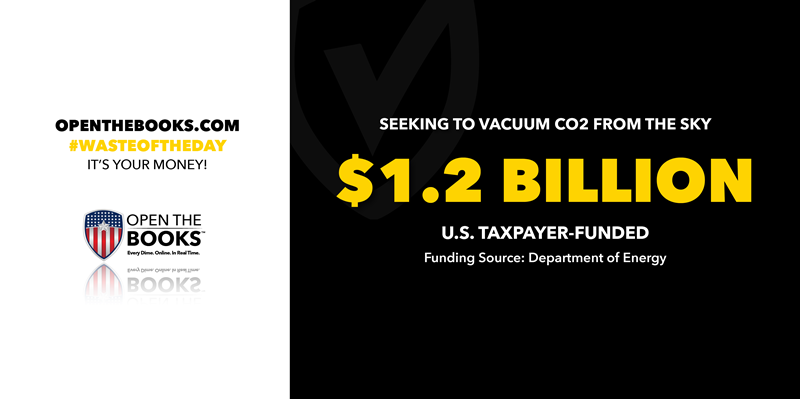
The Department of Energy is spending $1.2 billion on experimental technology that tries to vacuum greenhouse gasses out of the sky, despite many scientists’ concerns over its efficacy and potential, according to The New York Times.
In announcing the funding, U.S. Secretary of Energy Jennifer Granholm described two large projects that would use a nascent technology known as direct air capture to vacuum carbon dioxide from the atmosphere.
There are 30 such facilities around the world but these two in Texas and Louisiana would be the largest.
The recipients of the funding are Occidental Petroleum, an oil company in Kleberg County, Texas, and Battelle, a non-profit in Calcasieu, Louisiana. Both are equally splitting the cost of building the facilities with the federal government.
The Biden administration is touting this massive investment as another part of its fight against climate change. Some scientists, however, remain skeptical of the technology’s potential. Both George W. Bush and Barack Obama tried funding this technology with investments of $1 billion, only for the project to be shut down because it couldn’t be used on a commercial scale.
Even climate activists like former Vice President Al Gore have criticized this technology, noting that it is incredibly expensive and uses “so much energy that it would make more sense to prevent carbon emissions in the first place rather than try to clean them up after the fact,” The Times reported.
Unfortunately, more funding for this highly experimental technology may be on the way. The 2021 Bipartisan Infrastructure Act set aside $3.5 billion for constructing four plants like these, meaning there will soon be another expenditure of about $2.3 billion on two more facilities.
This is only a small part of the $370 billion the Biden administration has spent to fight climate change, though The Times argues all this funding will still not be enough to reach the goal of halving greenhouse gas emissions by 2030.
While some may reasonably argue the government has a role to play in the fight against climate change, shoveling billions out the door on untested technology only to still fall short of meaningful change is wasteful and irresponsible.
Virginia Has $870 Million in Questioned Costs from CARES Funding
September 5, 2023
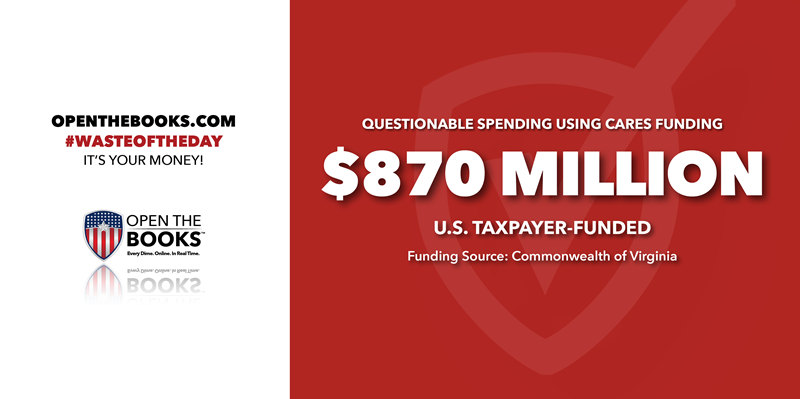
Virginia had more than $870.6 million in questioned spending using federal funding from the pandemic-era CARES Act, an accounting and auditing firm said in a recent memo to the Treasury Department’s Inspector General.
The firm Castro & Company reviewed transactions made using the funding, made possible through GrantSolutions.
The CARES Act stipulated that states had to report information like the total amount of "large covered funds" that were received and spent, along with the projects they were spent on and any subcontracts or subgrants that were involved.
Castro & Company reviewed 50 transactions made by Virginia in the GrantSolutions portal and found that “Virginia did not comply with the CARES Act and Treasury’s Guidance.”
Castro questioned $870.6 million worth of expenditures and concluded that “Virginia’s risk of unallowable use of funds is high.”
Spending is a “questioned cost, according to federal regulations:
(a) which resulted from a violation or possible violation of a statute, regulation, or the terms and conditions of a Federal award, including for funds used to match Federal funds;
(b) where the costs, at the time of the audit, are not supported by adequate documentation; or
(c) where the costs incurred appear unreasonable and do not reflect the actions a prudent person would take in the circumstances.
For context, Virginia received $3.1 billion in such funds, meaning about 28% of expenditures resulted in questioned costs. Castro has recommended that the Treasury Inspector General follow up with Virginia to ensure compliance in reporting.
If states accept and spend federal funds, the least they can do is take the time to comply with the law and report spending so the federal government can provide oversight. Now, without additional information, it’s impossible to determine if these costs went to legitimate relief programs, or if they were spent on wasteful pet projects so common in the pandemic era.
State Dept. to Spend $80K on Model UN in Nepal
September 6, 2023
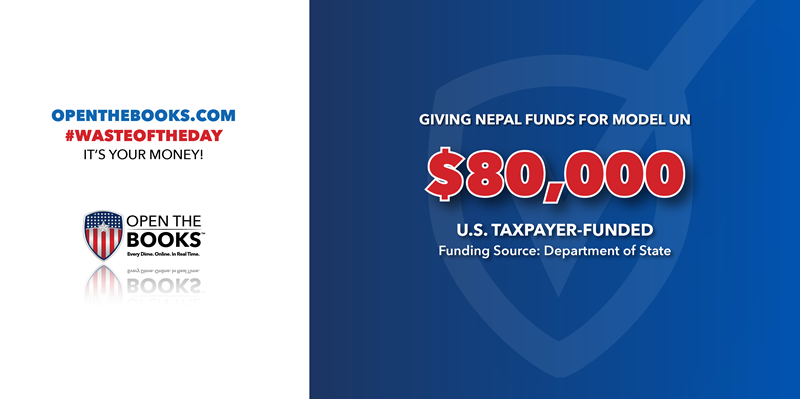
The State Department’s U.S. Embassy to Nepal in Kathmandu will spend $80,000to throw a Model United Nations conference in Nepal.
Model UN is an extracurricular activity where students role play politicians or representatives in simulations of government bodies.
The Embassy would like to bring this activity to Nepal, where grantees are asked to organize a five-day conference for over 200 people aged 20-30 from “across the South and Central Asia Region and all seven provinces of Nepal” in summer 2024.
The conference should include people with at least a bachelor’s degree and the group of participants should be at least 50% female and represent “Nepal’s cultural, religious, ethnic, and social diversity.” There will be smaller regional simulations hosted in all seven provinces, and a larger conference in Kathmandu.
Participants can expect to enjoy a series of workshops on what Model UN is and how to participate in it, opening and closing events, a welcome reception, expert speaker sessions, experimental learning days, and interactions with U.S. representatives.
While this may be a fun experience for young adults in Nepal, there are better uses for this money. Nepal is ranked 99th in GDP per capita, meaning welfare and poverty reduction programs are probably needed far more than a pretend political conference.
Additionally, there are plenty of students in the U.S. who would benefit from the funding so that they could attend Model UN simulations at home.
The government can’t fund every project in every country in the world. Cutting spending on events in foreign countries that have no tangible benefit for the U.S. would be a good first step to reining in out-of-control spending.
Throwback Thursday: Army Corps Increased Travel by $370,000
September 7, 2023
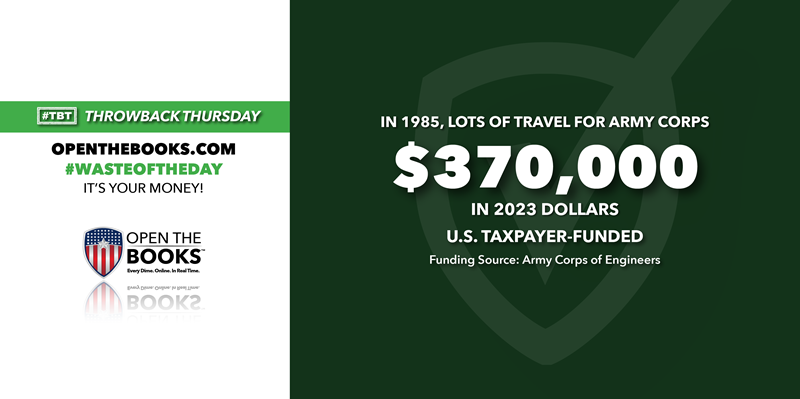
Throwback Thursday!
From 1983 to 1985, the Army Corps of Engineers increased their foreign travel spending by $130,000 – worth about $370,000 in 2023 dollars – despite its total budget falling by about 3%.
Sen. William Proxmire, a Democrat from Wisconsin, awarded the Army Corps of Engineers his Golden Fleece Award for these adventurous foreign trips at the expense of other critical projects.
According to Proxmire, the Corps’ spending on foreign travel increased from $276,662 in 1983 to $406,638 in 1985, a 47% increase. This was mainly due to increases in the frequency of Corps members trips.
In 1983, only 275 Corps members took international trips. Those trips were mostly in this hemisphere, lasted about six days on average, and cost taxpayers about $1,000 per trip. By 1985, however, 413 members traveled internationally, about a 50% increase. Even with similar destinations, durations, and costs, the increase in the volume of trips caused costs to balloon.
While this increase in travel would be bad enough on its own, it came in tandem with a decrease of 3% in the Corps’ total budget. This meant the Corps did fewer projects at home, with many of those overpromising and underdelivering, leading to a gradual disenchantment with the Corps mission.
The Corps primary mission is to serve American citizens through infrastructure projects, not to travel the world on various excursions. When faced with budget cuts, they should have doubled down on their core mission. Instead, they let their domestic work continue to dwindle while enjoying foreign trips, which both wasted money and eroded public trust.
Big Name Musicians Received $200 Million in Covid Aid
September 8, 2023
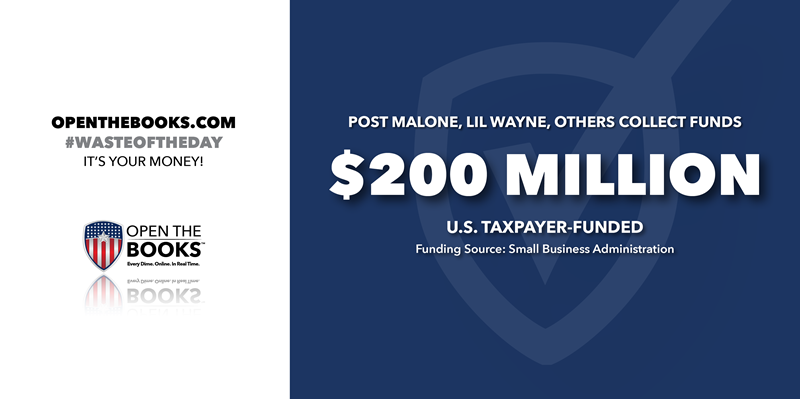
Dozens of superstar music artists like Post Malone, Chris Brown, Nickelback, and Lil Wayne received over $200 million in pandemic relief funds through the Shuttered Venue Operators Grant program, according to Insider.
The program had $14.5 billion from the Small Business Administration to support businesses like theaters, opera houses, and other performing arts venues that were closed due to COVID lockdowns. Qualified applicants could receive up to $10 million in forgivable loans.
Many popular performing artists quickly found ways to game the system. With the help of an asset management firm called NKSFB, dozens of artists funneled the money to LLCs and subsidiaries in their name, where the funds could then be used for “owner compensation.”
Big names raked in millions, Insider reported. Post Malone and Chris Brown both received the max $10 million in funds, while Slipknot pulled in $9.7 million, and Lil Wayne got $8.9 million. Insider’s analysis found that over $200 million went to “big-name artists.”
These handouts were not the result of fraudulent applications or dubious money laundering. These artists took advantage of a poorly written law. Loopholes allowed this waste to take place. There were no income phase-outs or need-based requirements, artists were included as an eligible profession to receive funding, and they were able to use funds for owner compensation.
This program also could have given businesses low interest loans that would allow them to stay open in the short term, but also ensure the money would be returned and that businesses would have skin in the game.
Thanks to this poorly written law, millionaires got richer at taxpayers’ expense, while small businesses struggled to navigate the complex bureaucracy for limited funds.
The #WasteOfTheDay is presented by the forensic auditors at OpenTheBooks.com.